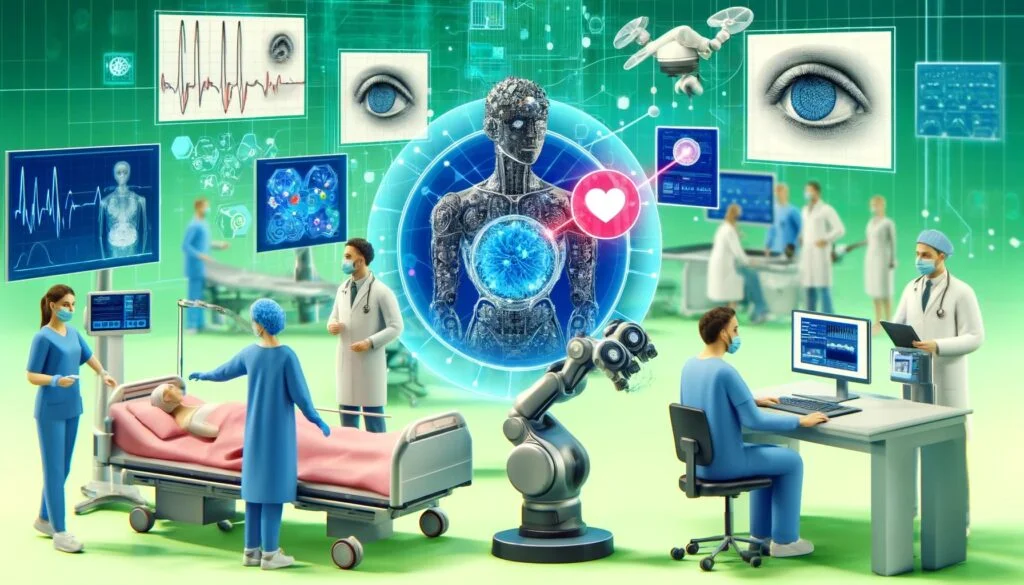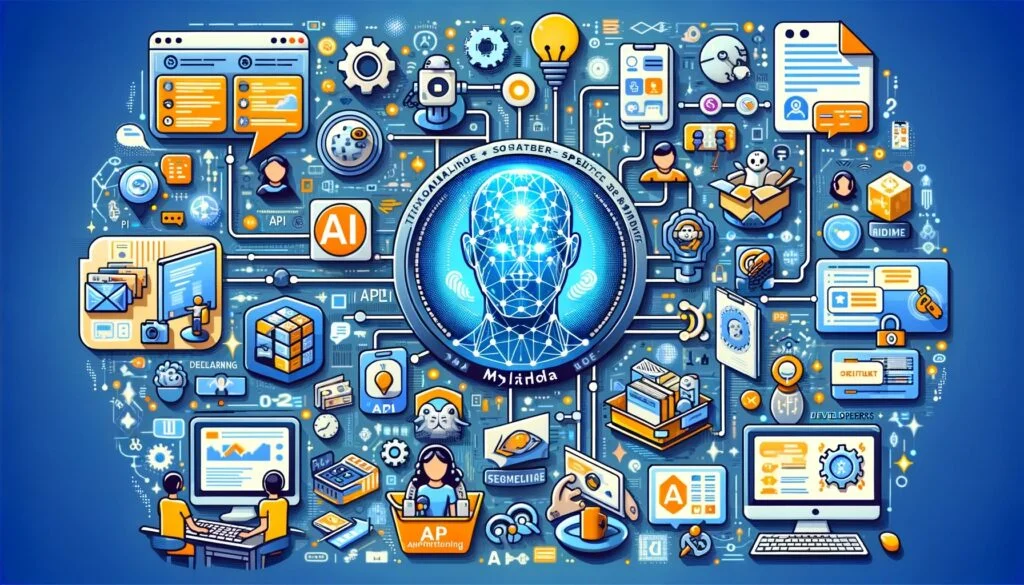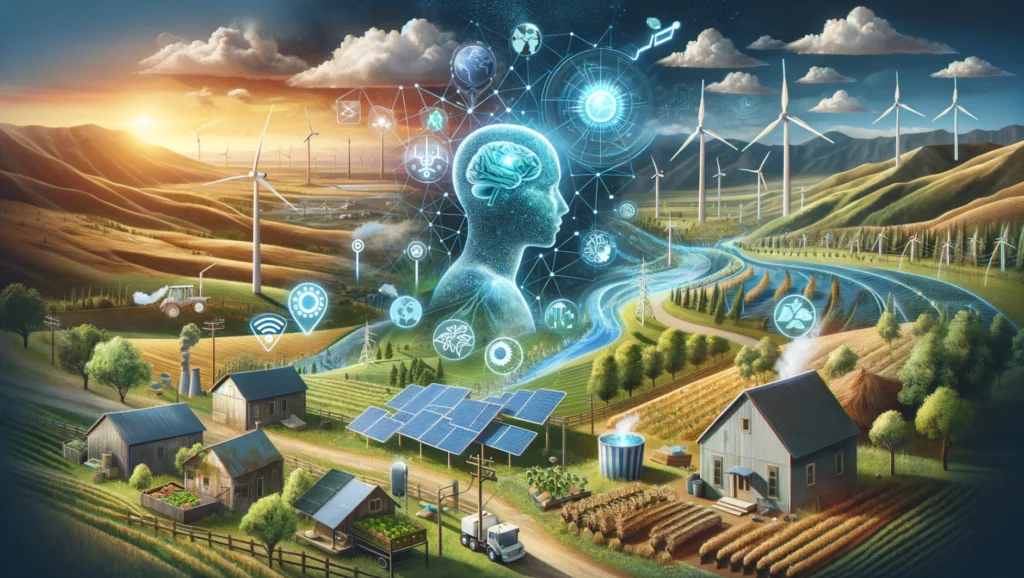As we navigate through 2024, artificial intelligence (AI) continues to evolve and drive significant changes across various sectors. The rapid advancement of AI technologies is transforming industries and redefining how we interact with machines and utilize data. From creative applications in art and entertainment to critical roles in healthcare, finance, and climate change mitigation, AI’s influence is expanding at an unprecedented rate. The integration of AI into everyday life brings both opportunities and challenges, prompting ongoing discussions about ethical considerations, transparency, and the need for robust regulatory frameworks.
Several key trends are shaping the AI landscape, each offering unique implications and potential impacts. Innovations in generative AI, multimodal AI, and API-driven applications are enhancing productivity and enabling new capabilities across diverse fields. Meanwhile, the push for ethical AI development and the implementation of responsible AI frameworks aim to address concerns about bias, privacy, and accountability. As researchers and industry leaders continue to explore and develop these technologies, it is crucial to stay informed about the latest trends and research findings to understand the future trajectory of AI and its role in shaping our world
1. Generative AI and Creative Applications

Generative AI, particularly models like GPT-4 and DALL-E, has gained immense popularity. These models are transforming creative industries by enabling artists, writers, and designers to produce novel content that blends human ingenuity with machine precision. Notably, AI is now extensively used in film production for tasks such as lip-syncing actors’ performances to multiple foreign-language overdubs and enhancing special effects. This was exemplified in movies like “Indiana Jones and the Dial of Destiny” where a de-aged version of Harrison Ford was created using AI-generated special effects. The democratization of AI tools, making them accessible and user-friendly, has further accelerated their adoption. Platforms like Runway’s AI film festival showcase experimental movies made with AI tools, reflecting the growing influence of AI in the creative sector.
Recent research in generative AI is focusing on improving the efficiency and accessibility of these models. Techniques like Low Rank Adaptation (LoRA) and quantization are being developed to reduce the computational resources required for training and fine-tuning models, making advanced AI capabilities more accessible to smaller organizations and individuals. LoRA, for instance, dramatically speeds up fine-tuning by reducing the number of parameters that need to be updated, while quantization lowers the precision of model data points to reduce memory usage and speed up inference. These advancements are not only lowering the barriers to entry for small businesses and independent creators but also enhancing the scalability of AI applications across various creative fields.
Generative AI’s impact extends beyond traditional media. In marketing and sales, these models are revolutionizing content creation and customer engagement. AI-driven tools can generate personalized marketing materials, analyze client profiles, and create custom content, significantly enhancing sales productivity and customer experiences. For example, Synthesia’s technology, which converts a single actor’s performance into multiple deepfake avatars, is now used by 44% of Fortune 100 companies to streamline their marketing efforts.
Moreover, AI’s role in creative processes is continually expanding, with virtual agents and chatbots becoming more sophisticated and capable of handling complex tasks. This evolution is leading to a broader range of applications, from automating customer service to aiding in design and content generation, making generative AI an indispensable tool in the modern creative and business
2. AI in Healthcare

AI is revolutionizing healthcare by enhancing diagnostic accuracy, streamlining administrative tasks, and improving patient outcomes. Recent advancements in natural language processing (NLP) enable better interpretation of medical records, allowing for more accurate patient histories and personalized treatment plans. Machine learning algorithms are assisting in early disease detection, such as identifying patterns in patient data that may indicate the onset of conditions like diabetes or cardiovascular diseases. Additionally, AI tools are being used to predict weather, estimate carbon emissions, and support sustainable farming practices, showcasing AI’s versatility in addressing global challenges like climate change.
In recent research, AI models have shown significant improvements in medical imaging, predicting patient outcomes, and drug discovery. For instance, AI-driven analysis of medical images has enhanced the early detection of diseases like cancer, significantly improving treatment outcomes. Deep learning models can now analyze radiology images with high precision, identifying anomalies that might be missed by human eyes. Companies like Zebra Medical Vision and Aidoc are leading the way in using AI to interpret medical imaging, offering tools that can detect a range of conditions from breast cancer to liver diseases.
AI’s impact extends to predicting patient outcomes and personalizing treatments. Predictive analytics, powered by AI, help in forecasting patient responses to various treatments, enabling healthcare providers to tailor interventions more effectively. For example, IBM Watson Health uses AI to analyze clinical trial data and scientific literature, providing oncologists with evidence-based treatment options for cancer patients. Moreover, AI is accelerating drug discovery by identifying potential drug candidates and predicting their effectiveness, thus reducing the time and cost associated with bringing new drugs to market. Companies like Atomwise and BenevolentAI are utilizing AI to sift through vast datasets of chemical compounds, expediting the drug discovery process.
Furthermore, AI is streamlining administrative tasks within healthcare institutions. Automated systems for scheduling, billing, and patient management are reducing the burden on healthcare staff, allowing them to focus more on patient care. For example, AI-powered chatbots are now handling routine inquiries and appointment bookings, improving efficiency and patient satisfaction. These advancements not only improve operational efficiency but also enhance the overall patient experience, making healthcare more accessible and effective.
3. Ethical AI and Responsible AI Development
As AI systems become more integrated into daily life, ethical concerns around bias, privacy, and transparency are growing. In 2023, the European Union made significant strides with the proposed EU AI Act, which aims to regulate AI deployment and mitigate associated risks. This legislation categorizes AI systems based on their risk levels and imposes corresponding obligations to ensure they are developed and used responsibly. High-risk AI systems, such as those used in healthcare, transportation, and employment, will be subject to stringent oversight and transparency requirements. The EU AI Act also seeks to prohibit certain AI applications that pose unacceptable risks, such as social scoring and biometric surveillance.
Organizations are increasingly adopting frameworks for responsible AI to ensure fairness, accountability, and inclusivity in AI development. Research in this area focuses on developing robust methodologies to identify and mitigate biases in AI models. For instance, IBM’s AI Fairness 360 toolkit and Google’s What-If Tool are examples of efforts to address bias in AI systems. Additionally, there is a strong emphasis on creating transparent AI systems that can explain their decision-making processes, thereby building trust with users and stakeholders. Transparency and explainability are crucial in high-stakes areas like finance and healthcare, where understanding how decisions are made can significantly impact individuals’ lives. By prioritizing ethical AI development, organizations can ensure that AI technologies are used to benefit society while minimizing potential harms.
4. AI and Automation in the Workplace

AI-driven automation is transforming the workplace by automating repetitive tasks and augmenting human capabilities. In manufacturing, AI-powered robots and systems are optimizing production lines, improving quality control, and reducing downtime. For example, companies like Siemens and General Electric use AI for predictive maintenance, which anticipates equipment failures before they occur, thus minimizing operational interruptions and maintenance costs. This proactive approach not only enhances productivity but also ensures a safer working environment by preventing accidents related to equipment malfunctions.
In the finance sector, AI is revolutionizing tasks such as data analysis, fraud detection, and customer service. AI algorithms can analyze vast amounts of financial data faster and more accurately than humans, identifying trends and anomalies that might indicate fraudulent activity. Companies like JPMorgan Chase are utilizing AI to scrutinize legal documents and investment banking contracts, significantly reducing the time required for these tasks and minimizing human error. Moreover, chatbots and virtual assistants powered by AI are improving customer service by providing instant, accurate responses to customer inquiries, thus enhancing the overall customer experience and reducing the workload on human employees.
The customer service industry is also experiencing significant changes due to AI automation. AI-driven chatbots and virtual assistants, such as those implemented by companies like Zendesk and Salesforce, handle a substantial volume of customer interactions, resolving common issues without human intervention. This not only improves response times and customer satisfaction but also allows human agents to focus on more complex queries that require a personal touch. Additionally, AI tools are being used to analyze customer feedback and interactions, providing valuable insights that help companies improve their services and tailor their offerings to better meet customer needs.
Despite these advancements, the rise of AI in the workplace raises concerns about job displacement. Automation is expected to replace certain roles, particularly those involving routine and repetitive tasks. However, it also creates new opportunities for jobs that require advanced technical skills and human creativity. As a result, there is an increasing need for workforce reskilling and upskilling. Programs focused on teaching employees how to work alongside AI, develop new skills, and adapt to changing job requirements are essential. For instance, initiatives like Amazon’s Upskilling 2025 are investing in training programs to help employees transition into more tech-centric roles, ensuring they remain valuable assets in an AI-driven world.
5. Multimodal AI and API-driven Applications

The integration of multimodal AI, which combines text, speech, and images, is creating more contextually relevant responses and fostering innovation across diverse sectors. This technology is particularly beneficial in customer service, where AI can analyze spoken requests, interpret documents, and assess facial expressions in video consultations to provide personalized advice. For instance, a customer service chatbot equipped with multimodal AI can understand a customer’s spoken complaint, cross-reference the relevant documents for solutions, and gauge the customer’s emotions through facial expressions during a video call. This level of contextual understanding allows for more accurate and empathetic responses, significantly enhancing the customer experience.
Additionally, the proliferation of API-driven AI and microservices is simplifying the creation of complex AI-driven applications, boosting productivity across various sectors. By leveraging APIs, developers can integrate sophisticated AI functionalities into their applications without needing to build these capabilities from scratch. For example, IBM’s suite of custom AI microservices includes tools for customer behavior analysis, inventory management, and personalized marketing, all accessible via APIs. This approach not only accelerates the development process but also allows businesses to quickly adapt to market changes and scale their AI capabilities efficiently. API-driven solutions are proving to be especially valuable in fields such as finance, healthcare, and retail, where they enhance operational efficiency and drive innovation.
The combination of multimodal AI and API-driven applications is fostering a new era of intelligent systems that can seamlessly integrate and interact with multiple data types and services. This synergy is paving the way for more advanced and user-friendly applications, from virtual assistants that can manage entire workflows to AI-driven analytics platforms that provide real-time insights across various data streams. As these technologies continue to evolve, they are set to revolutionize the way businesses operate and interact with their customers, creating a more connected and efficient digital ecosystem.
6. AI in Climate Change Mitigation

AI is playing a pivotal role in addressing climate change by leveraging advanced algorithms to model climate patterns, optimize energy consumption, and develop sustainable practices. One of the key collaborations in this area is between IBM and NASA, which focuses on creating open-source AI models for tasks such as deforestation tracking and greenhouse gas detection. These models utilize satellite imagery and other data sources to monitor environmental changes in real-time, providing critical insights for policymakers and environmentalists.
In addition to deforestation tracking, AI is being used to optimize energy consumption in various sectors. For example, AI algorithms can predict energy demand and manage supply more efficiently, reducing waste and enhancing the use of renewable energy sources. Companies like Google have implemented AI to optimize the cooling systems in their data centers, resulting in a 40% reduction in energy used for cooling. Similarly, AI-driven smart grids are being developed to manage energy distribution more effectively, balancing load and integrating renewable energy sources into the power supply.
Moreover, AI is instrumental in developing sustainable agricultural practices. By analyzing data on soil health, weather patterns, and crop performance, AI systems can provide farmers with precise recommendations on irrigation, fertilization, and pest control. This not only improves crop yields but also reduces the environmental impact of farming by minimizing the use of water, fertilizers, and pesticides. These advancements are crucial for developing effective strategies to combat climate change and ensure a sustainable future.
7. AI-generated Election Disinformation
The use of AI-generated content in political campaigns is raising significant concerns about misinformation and its impact on elections. AI tools, particularly those capable of creating deepfakes, have been used to generate misleading content that can manipulate public opinion and undermine trust in electoral processes. For example, during recent elections in Argentina and Slovakia, AI-generated images and videos were employed to spread false information about political candidates, complicating efforts to maintain the integrity of these elections.
The proliferation of AI-generated disinformation highlights the urgent need for robust techniques to track and mitigate such content. Current methods for detecting deepfakes and other forms of AI-generated media are still in their infancy and often struggle to keep up with the rapid advancements in AI technology. Researchers are developing more sophisticated detection algorithms and digital watermarking techniques to identify and flag fake content. For instance, Google DeepMind’s SynthID project is working on embedding imperceptible watermarks into AI-generated images to help verify their authenticity. However, these measures are not yet foolproof, and the battle against AI-generated disinformation is likely to continue as AI tools become more accessible and their outputs more convincing.
Moreover, social media platforms and regulatory bodies are increasingly under pressure to address the spread of AI-generated disinformation. Platforms like Facebook and Twitter are implementing stricter content moderation policies and collaborating with fact-checking organizations to identify and remove false content. Governments are also considering legislative measures to regulate the use of AI in political campaigns. For instance, the European Union’s proposed AI Act includes provisions aimed at preventing the misuse of AI in creating and spreading disinformation. As AI-generated disinformation becomes more prevalent, the combined efforts of technology developers, policymakers, and social media platforms will be crucial in safeguarding the integrity of electoral processes.
What’s Next for AI?
The future of AI holds immense potential for further advancements and applications, with current research focusing on improving efficiency, transparency, and ethical deployment. Here are some key areas of development:
Model Efficiency
Ongoing research aims to make AI models more efficient and accessible. Efforts are underway to refine techniques that reduce the computational resources required for training and deploying AI systems. This includes improving methodologies to enhance the performance of AI models without necessitating significant infrastructure investments, which is crucial for democratizing access to advanced AI capabilities.
Personalized AI Systems
Developing AI models that can be customized for specific applications is a major focus. Personalized AI systems aim to provide more accurate and relevant results by tailoring capabilities to the unique needs of different industries such as healthcare, legal, and finance. For example, in healthcare, personalized AI can analyze patient data to deliver individualized treatment plans, enhancing patient outcomes. In finance, AI can improve fraud detection and provide tailored financial advice, thus driving significant improvements in efficiency and effectiveness across various professional fields.
Advancements in AI Safety and Transparency
As AI continues to integrate more deeply into everyday life, ensuring its ethical deployment is paramount. Research is focused on developing robust frameworks and methodologies to address bias, privacy, and transparency issues. This includes creating transparent AI systems that can explain their decision-making processes, thereby building trust with users and stakeholders. These efforts are essential for maintaining public trust and ensuring that AI technologies are used responsibly and ethically.
By focusing on these key areas, the future of AI promises to bring significant advancements that will enhance various aspects of technology and society. As these technologies continue to develop, they will play a crucial role in shaping the future of numerous industries and improving our daily lives.
Conclusion
The current trends in AI highlight its transformative potential across multiple domains. From creative applications and healthcare to ethical considerations and climate change mitigation, AI is reshaping how we live and work. As AI continues to evolve, it is essential to navigate these trends with a focus on innovation, responsibility, and inclusivity. By harnessing the power of AI thoughtfully and ethically, we can unlock new possibilities and drive progress towards a better future.
Staying informed about these trends is crucial for anyone involved in the field. The collaboration between humans and AI will undoubtedly lead to groundbreaking advancements, propelling us into a new era of technological evolution.




